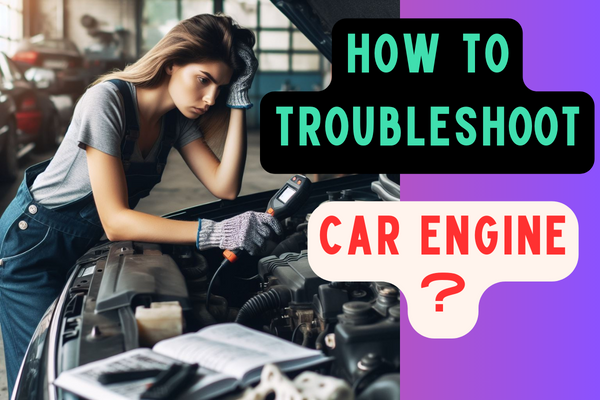Your car’s engine is its heart, and when problems emerge, it’s critical to detect and solve them right away. Understanding how to troubleshoot car engine problems can save you time, money, and frustration. In this article, we will go over step-by-step procedures for identifying and resolving common car engine issues.
1. Preliminary Checks
Before diving into specific troubleshooting steps, there are a few preliminary checks you can perform to gather information about your engine’s health.
(a) Check Engine Light (CEL)
The Check Engine Light (CEL) is your car’s way of warning you that something is wrong. If the CEL glows, use an OBD-II scanner to obtain diagnostic issue codes. These codes can provide valuable information about the nature of the problem.
(b) Listen for Unusual Noises
Strange noises such as knocking, tapping, or hissing may signal a variety of engine problems. A knocking sound, for example, could indicate an issue with the engine’s bearings or piston rings, whereas a hissing noise could indicate a vacuum leak.
(c) Inspect Fluid Levels
Check the levels and condition of essential fluids such as engine oil, coolant, and transmission fluid. Low levels or dirty fluids can lead to engine problems and should be addressed promptly.
2. Step-by-Step Troubleshoot car engine Process
-
Identify the Symptoms
Car engine problems often manifest through specific symptoms. Here are some common signs to look out for:
- Engine Misfiring: A misfiring engine can indicate issues with spark plugs, ignition coils, or fuel injectors.
- Loss of Power: This could be caused by fuel system problems, a clogged air filter, or exhaust issues.
- Strange Odors: Unusual smells like burnt oil or coolant could indicate leaks or overheating.
- Smoke from the Exhaust: Different colors of smoke (white, blue, or black) can signal various engine problems, such as burning oil or coolant leaks.
-
Diagnostic Steps
Once you’ve identified the symptoms, follow these diagnostic steps to pinpoint the problem:
- Check Engine Oil: Inspect the oil level and condition. Low oil levels or dirty oil can lead to engine damage.
- Inspect Spark Plugs: Remove the spark plugs and inspect them for fouling or wear. Replace them if necessary.
- Examine Air Filter: A clogged air filter can restrict airflow to the engine, leading to performance issues. Replace the air filter if it’s dirty or damaged.
- Scan for Error Codes: Use an OBD-II scanner to retrieve diagnostic trouble codes (DTCs) from the engine control unit (ECU). These codes can provide valuable clues about the nature of the problem.
3. Common Engine Problems and Solutions
Now some common engine problems and their solutions after troubleshoot car engine.
-
Misfiring Engine
If your engine is misfiring, it’s crucial to address the underlying cause promptly. Possible causes and solutions include:
- Spark Plug Issues: Replace worn or fouled spark plugs to restore proper ignition.
- Ignition System Problems: Check ignition coils, ignition wires, and the distributor for faults.
- Fuel Delivery Issues: Inspect the fuel injectors and fuel pump for clogs or malfunctions.
-
Overheating
An overheating engine can lead to serious damage if not addressed quickly. Here’s how to troubleshoot overheating issues:
- Coolant Leaks: Inspect hoses, radiator, and water pump for leaks. Replace any damaged components.
- Faulty Thermostat: A stuck thermostat can cause the engine to overheat. Replace it if necessary.
- Radiator Issues: Check for clogs or damage to the radiator fins. Flushing the radiator may also help.
-
Loss of Power
If your car is experiencing a loss of power, consider the following potential causes and solutions:
- Fuel System Problems: Inspect the fuel filter, fuel injectors, and fuel pump for clogs or malfunctions.
- Clogged Air Filter: Replace the air filter if it’s dirty or clogged to improve airflow to the engine.
- Exhaust Issues: Check for leaks or obstructions in the exhaust system. Repair or replace damaged components as needed.
4. Advanced Troubleshooting
Now we will discuss some advance troubleshooting after understanding troubleshoot car engines common problems.
-
Compression Test
A compression test can help diagnose engine problems related to cylinder compression. Here’s how to perform a compression test and interpret the results.
-
Inspect Timing Belt/Chain
The timing belt or chain is crucial for the proper operation of the engine. Inspect it for signs of wear or damage, and replace it if necessary to prevent catastrophic engine failure.
5. When to Seek Professional Help
While many engine problems can be diagnosed and addressed by DIY enthusiasts, some issues require professional expertise. If you face some problems with troubleshoot car engine Consider seeking help from a qualified mechanic if:
- You’re unable to diagnose the problem using basic troubleshooting methods.
- The repairs require specialized tools or equipment.
- The problem poses a safety risk or could cause further damage if not addressed correctly.
Understanding how to troubleshoot car engine problems is critical to preserving your vehicle’s performance and dependability. Following the procedures indicated in this tutorial will allow you to diagnose and repair common engine faults quickly, saving you time and money in the long run. To keep your automobile running smoothly, schedule regular maintenance inspections and treat any concerns as soon as they create.
FAQ
Why is it important to troubleshoot car engine problems?
What are the most common signs of engine problems?
How can I check for engine problems at home?
What should I do if my engine is misfiring?
How can I prevent my engine from overheating?
What should I do if my car experiences a loss of power?
When should I seek professional help for engine problems?
Still have more questions?
How to Choose the Right Tires for Your Car? – 5 Simple Guide

4 thoughts on “How to troubleshoot car engine problems | 5 Simple guide.”